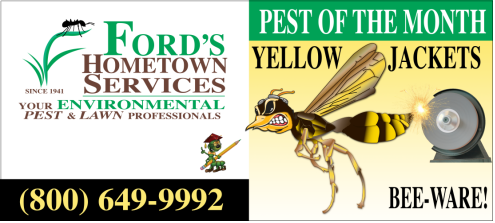Ford’s Pest of the Month: Yellow Jackets
| . Posted in extermination - 0 Comments
 Yellow jackets are considered beneficial social wasps feeding on sweet secretions and other insects but can become a homeowner’s worst nightmare. The fertilized queen from the prior fall is the only survivor of the winter. In the spring, she seeks a nesting site in wall voids, stonewalls, in the ground, and in shrubs. Ten to twenty eggs are initially laid in her newly constructed nest, which are fed and tendered by her until they reach adulthood. Now her duties become strictly egg laying and her new adult workers support her new offspring while developing the nest.
Yellow jackets are considered beneficial social wasps feeding on sweet secretions and other insects but can become a homeowner’s worst nightmare. The fertilized queen from the prior fall is the only survivor of the winter. In the spring, she seeks a nesting site in wall voids, stonewalls, in the ground, and in shrubs. Ten to twenty eggs are initially laid in her newly constructed nest, which are fed and tendered by her until they reach adulthood. Now her duties become strictly egg laying and her new adult workers support her new offspring while developing the nest.
When fall arrives; the nest becomes noticeable in size as it may contain thousands of worker wasps. We get the majority of Yellow Jacket calls at the end of August till mid October. Homeowners should never attempt to treat a yellow jacket nest which requires a ladder or if you are unsure if you are allergic. By late fall the colony produces new queens who become fertilized, fly off to over-winter and so the cycle continues.
How we can help
Our technicians use many methods (sprays, organics, dusts and special equipment) to eradicate yellow jackets depending on where the nest is located. Because we are treating during the day- while the nest is active, we must leave the nest up allowing all members of the colony to return into the treated nest so we know all members of the colony will die. If the nest is knocked down, the yellow jackets out foraging for food will return and start rebuilding a new nest. Post treatment: There may be some hatching of drones, but with no colony members assisting, they will soon die. A homeowner should never attempt daytime treatment.
Are you beeing bugged? Contact us at FordsHometown.com!
Geoffrey Ford, Vice President
Ford’s Hometown Services




